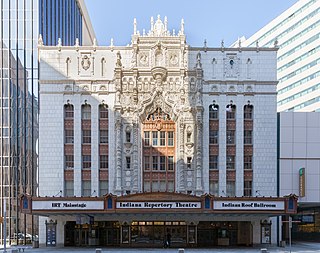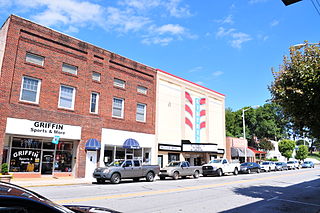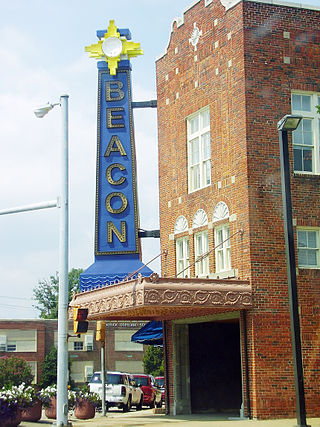
Canton is the second largest town in Haywood County, North Carolina, United States. It is located about 17 miles (27 km) west of Asheville and is part of that city's metropolitan area. The town is named after the city of Canton, Ohio. The population was 4,422 at the 2020 census.

The Auditorium Building in Chicago is one of the best-known designs of Louis Sullivan and Dankmar Adler. Completed in 1889, the building is located at the northwest corner of South Michigan Avenue and Ida B. Wells Drive. The building was designed to be a multi-use complex, including offices, a theater, and a hotel. As a young apprentice, Frank Lloyd Wright worked on some of the interior design.

The Carolina Theatre is a performing arts and cinema complex in downtown Durham, North Carolina. The facility is operated by a nonprofit organization named The Carolina Theatre of Durham, Inc. under a management agreement with the City of Durham, which owns the complex.

Allen University is a private historically black university in Columbia, South Carolina, United States. It has more than 600 students and still serves a predominantly Black constituency. The campus is listed on the National Register of Historic Places as Allen University Historic District.

The Hollywood Theatre is a historic movie theater in northeast Portland, Oregon built in 1926. It is a central historical landmark of the Hollywood District, which is named after the theatre itself. The theatre is located at 4122 NE Sandy Blvd, and is operated by a non-profit organization. The Hollywood Theatre was placed on the National Register of Historic Places in 1983 and is considered to be a gem of Northeast Portland's historic culture and tradition. It is the only theater in Oregon showing movies in 70mm film.

John Adolph Emil Eberson was an Austrian-American architect best known for the development and promotion of movie palace designs in the atmospheric theatre style. He designed over 500 theatres in his lifetime, earning the nickname "Opera House John". His most notable surviving theatres in the United States include the Tampa Theatre (1926), Palace Theatre Marion (1928), Palace Theatre Louisville (1928), Majestic Theatre (1929), Akron Civic Theatre (1929), the Paramount Theatre (1929), the State Theater 1927, and the Lewis J. Warner Memorial Theater (1932) at Worcester Academy in Worcester, Massachusetts. Remaining international examples in the atmospheric style include both the Capitol Theatre (1928) and State Theatre (1929) in Sydney, Australia, The Forum and Le Grand Rex.
Colonial Theatre or Colonial Theater may refer to:

The Indiana Theatre is a multiple use performing arts venue located at 140 W. Washington Street in Indianapolis, Indiana. It was built as a movie palace and ballroom in 1927 and today is the home of the Indiana Repertory Theatre. It was added to the U.S. National Register of Historic Places in 1979. It is located in the Washington Street-Monument Circle Historic District.

The Playmakers Theatre, originally Smith Hall, is a historic academic building on the campus of the University of North Carolina at Chapel Hill. Built in 1850, it was designated a National Historic Landmark for its architecture, as an important example of Greek Revival architecture by Alexander Jackson Davis. It is now a secondary venue of the performing company, which is principally located at the Paul Green Theatre in the Joan H. Gillings Center for Dramatic Art.

The Majestic Theatre is a performing arts theater in the City Center District of Downtown Dallas. It is the last remnant of Theater Row, the city's historic entertainment center on Elm Street, and is a contributing property in the Harwood Street Historic District. The structure is a Dallas Landmark and is listed on the National Register of Historic Places.

The Downtown Main Street Historic District is a national historic district located at North Wilkesboro, Wilkes County, North Carolina. It encompasses 29 contributing buildings in the central business district of North Wilkesboro. It developed between about 1891 and 1952, and includes notable examples of Classical Revival and Early Commercial style architecture. The architectural firm Benton & Benton designed the former Bank of North Wilkesboro II (1923), the Hotel Wilkes (1926), and the former Town Hall (1939). Other notable buildings include the Liberty Theater, former Bank of North Wilkesboro (1892), and Tomlinson Department Store (1927).

The Lincoln Theatre, also known as Little Theatre on Lincoln Street, is a historic performance space at 1 Lincoln Street in New Haven, Connecticut. Built in 1924, it is the only known survivor in the state of the Little Theatre Movement of 1911-1933. The building was listed on the National Register of Historic Places in 1984. After a major rehabilitation in the 2010s, the theater was reopened, and is now known as the ACES Little Theatre.

The National Theater is a historic theater in Richmond, Virginia. Part of a section of Broad Street once known as Theatre Row, the National is the only one of the three original auditoriums still standing. Built in 1923, the theater was constructed with an adaptable stage that allowed it to show early motion pictures as well as live performances. It experienced a 1968 conversion to a dedicated cinema house and was renamed the TowneTheater, in which capacity it operated until closing in 1983. After an extensive renovation, the theater reopened in 2008 as The National, serving as a live music and performing arts venue.
Benton & Benton was an architectural partnership in eastern North Carolina of brothers Charles C. Benton Sr. and Frank W. Benton. Several of its works are listed on the U.S. National Register of Historic Places. Charles C. Benton Jr. and others also worked for the firm.

Colonial Theatre, also known as the Lochiel Hotel, is a historic theater and commercial building located at Harrisburg, Dauphin County, Pennsylvania. The building consists of a five-story, brick and frame front section and a rear brick and frame auditorium. The original Colonial Theatre was built about 1836, as a hotel in the Greek Revival style and featured a four columned portico on the Market Street entrance. It was subsequently modified in form and use a number of times. In the 1870s, a mansard roof was added. The rear auditorium was added in 1912, when the building was converted from a hotel to hotel and movie / vaudeville theater. The lobby was remodeled in the 1930s / 1940s in an Art Deco style; the auditorium has Italian Renaissance style detailing. The theater and hotel closed in 1976, and the building used for offices and shops.

The Canton Main Street Historic District is a national historic district located at Canton, Haywood County, North Carolina. It includes 34 contributing buildings and one other contributing structure and includes architecture by Benton & Benton. It includes Early Commercial architecture and Late 19th and 20th Century Revivals architecture. Located in the district is the separately listed Colonial Theater. Other notable buildings include the P L & S Building (1932), Champion Fibre Company Office Building (1918), Champion Bank and Trust, Imperial Hotel, and the former United States Post Office (1939).

The Palace Theater is a historic movie palace in downtown Canton, Ohio, United States. Constructed during the heyday of the movie palace in the 1920s, it has been named a historic site. The 21' x 46' screen is the largest in Canton as of 2019. It contains a Kilgen theater organ which is still playing to this day, thanks to an eight month restoration effort in 1992. Only a few dozen such organs are still operational at their original sites.

Beacon Theatre, also known as the Broadway Theatre and Pythian Lodge, is a historic theatre building located at Hopewell, Virginia.

Farmville Historic District is a national historic district located at Farmville, Pitt County, North Carolina. The district encompasses 330 contributing buildings, 1 contributing site, and 2 contributing structures in the central business district and surrounding residential sections of Farmville. It includes buildings dated from about 1860 to 1942 and notable examples of Colonial Revival, Classical Revival, and Queen Anne style architecture. Notable buildings include the James W. May House, Fields-Rasberry House, Dr. David Morrill House, Warren Parker House, Nannie Smith House, First Christian Church (1910), Emmanuel Episcopal Church (1920), St. Elizabeth Catholic Church, Municipal Building (1928) possibly designed by Benton & Benton, Bank of Farmville (1921) designed by Benton & Benton, Pollard Auto Company Building, Paramount Theatre (1930s), J. Y. Monk Tobacco Warehouse, and East Carolina Railway Office and Freight Station.

Sunset Theater is a historic movie theater located at Asheboro, Randolph County, North Carolina. It was designed by the architectural firm of Benton & Benton and built in 1929. It is a two-story, parapet roof load-bearing stuccoed brick building in the Spanish Colonial Revival style. It measures approximately 50 feet by 100 feet and has a large open auditorium seating 412. The theater was purchased by the City of Asheboro in 2005.





















